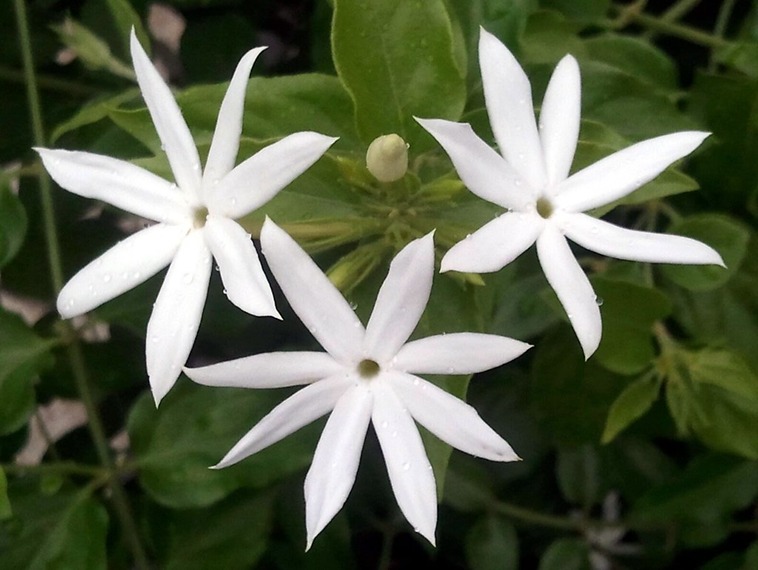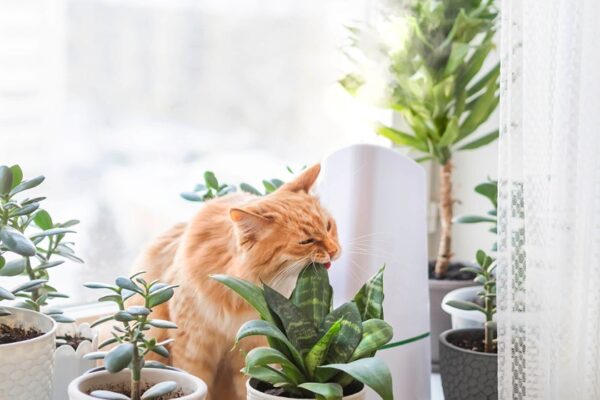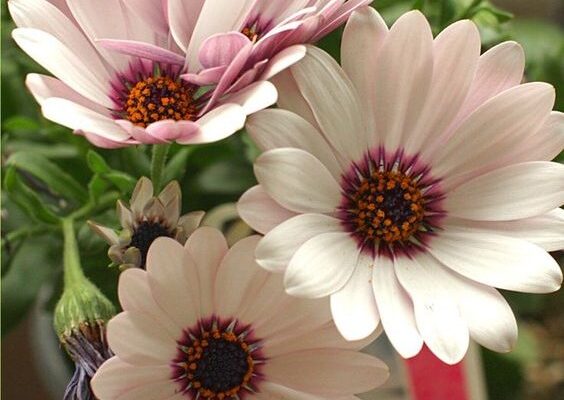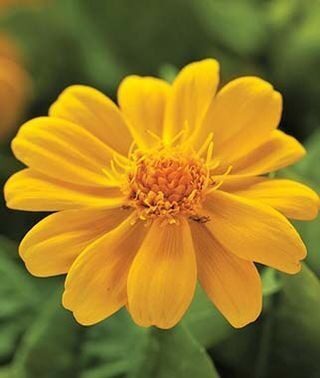14 Types of Jasmine to Delight Your Senses
Jasmine is renowned for its enchanting fragrance. When one thinks of it, different types of jasmine’s small white flowers with a distinct floral aroma come to mind. However, it’s important to note that certain types of jasmine showcase yellow or pink flowers and some may not possess any scent at all.
The scent of jasmine is highly captivating and renowned for its stress-relieving properties. In Hindu culture, jasmine is believed to symbolize divine hope. Notably, jasmine serves as the national flower of Pakistan, the Philippines, and Indonesia, symbolizing qualities such as modesty, love, attachment, and sensuality.

While the majority of jasmine species belong to the Jasminium genus, there are other plants referred to as jasmine that hail from different genera. For instance, star jasmine belongs to the Trachelospermum genus, and there are numerous members of the Chrysojasminum genus that are recognized as jasmine.
Jasmine plants can exhibit deciduous, evergreen, or semi-evergreen characteristics. Few varieties thrive in cold zones, with most requiring zone 6 or above to survive. In colder regions, individuals may opt to cultivate jasmine in containers and bring them indoors during the winter months.
Belonging to the family Oleaceae, jasmine is a beloved flower encompassing a genus of vines and shrubs. There exists a wide array of jasmine types across the globe, with approximately 200 known species. Explore some of the most breathtaking types of jasmine flowers below.
1. Angel Wing Jasmine
Scientific Name: Jasminum nitidum
Plant Type: Evergreen perennial
Plant Size: 20 ft
Sun Exposure: Full sun to part shade
Plant Zone: 9-11
Angel Wing Jasmine, scientifically known as Jasminum nitidum, is an evergreen perennial that operates as a vine. It is also commonly referred to as “shining jasmine.” This variety of jasmine is often used as a groundcover or to complement shrubs, and it can even be trained into a shrub-like shape. Care should be taken to prevent excessive growth and maintain control over the plant.
The distinctive feature of Angel Wing Jasmine is its big white flowers that emit an intoxicating scent. While its fragrance may not be as strong as other jasmine plants, it possesses unique characteristics. The blooms of this plant have thin, narrow petals and round centers.
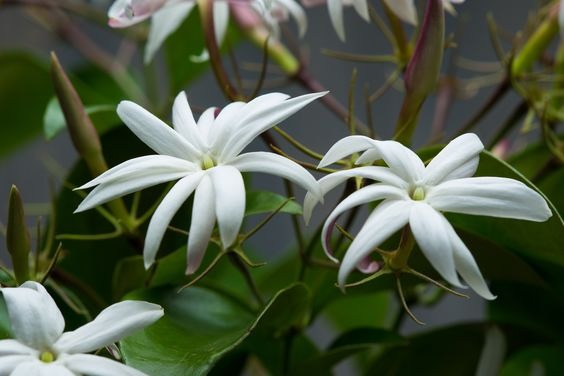
2. Royal Jasmine
Scientific Name: Jasminum nobile or Jasminum rex
Plant Type: Evergreen shrub
Plant Size: 15 ft
Sun Exposure: Full or part
Plant Zone: 10-11
Royal Jasmine, scientifically known as Jasminum nobile or Jasminum rex, is the perfect choice if you desire a fast-growing vine that quickly covers the designated area. This variety excels in climbing fences and adorning topiaries. Royal Jasmine stands out with its impressively large blooms compared to other jasmine plants. Although the fragrance of these flowers may not be as intense, they offer a pleasant scent that can be enjoyed throughout the year, as this plant tends to bloom almost constantly, even in colder seasons.
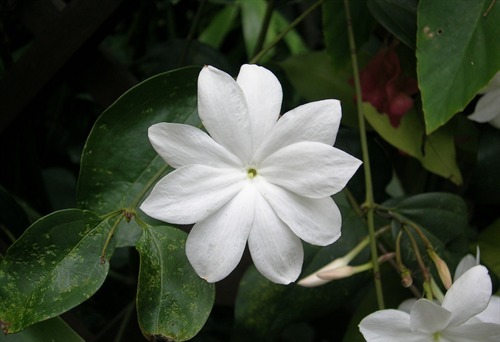
3. Arabian Jasmine
Scientific Name: Jasminum sambac
Plant Type: Evergreen vine
Plant Size: 10 ft
Sun Exposure: Full to partial sun
Plant Zone: 9-11
Arabian Jasmine, scientifically known as Jasminum sambac, is an evergreen vine originating from India and Southeast Asia. This variety stands out due to its many-petaled blooms and large round leaves. It is the same plant used to produce jasmine tea. The white flowers of Arabian Jasmine typically appear multiple times throughout the year and transition from pure white to a slight pink as they age.
While primarily a shrub, Arabian Jasmine can also be trained as a vine, offering flexibility in its usage. It’s worth noting that Arabian Jasmine holds the distinction of being the national plant of the Philippines.
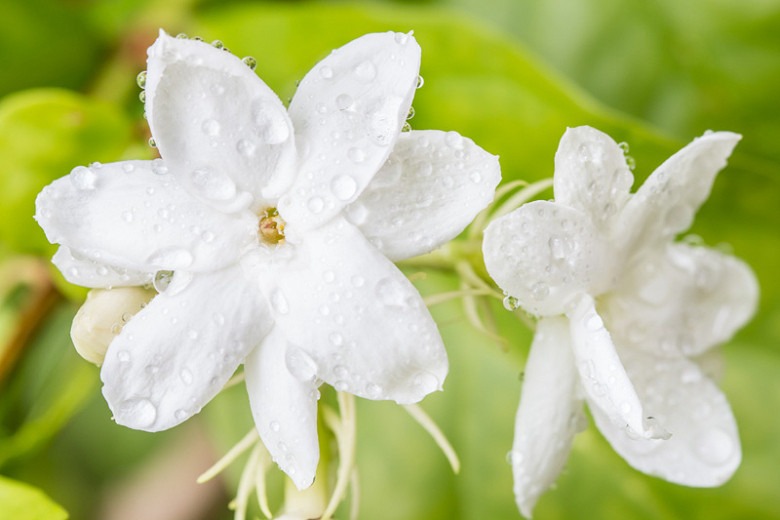
4. Winter Jasmine
Scientific Name: Jasminum nudiflorum
Plant Type: Deciduous
Plant Size: 4-15 ft
Sun Exposure: Full sun to part shade
Plant Zone: 6-10
Winter Jasmine, scientifically known as Jasminum nudiflorum, displays flowers that share the same shape as other jasmine varieties, featuring the vibrant yellow color commonly associated with jasmine plants.
The name of this plant originates from its distinctive blooming pattern, which occurs late in the year, long after many other plants have entered their dormant phase. Winter Jasmine exhibits higher tolerance to colder environments compared to other jasmine species, making it a suitable choice for regions with colder climates.
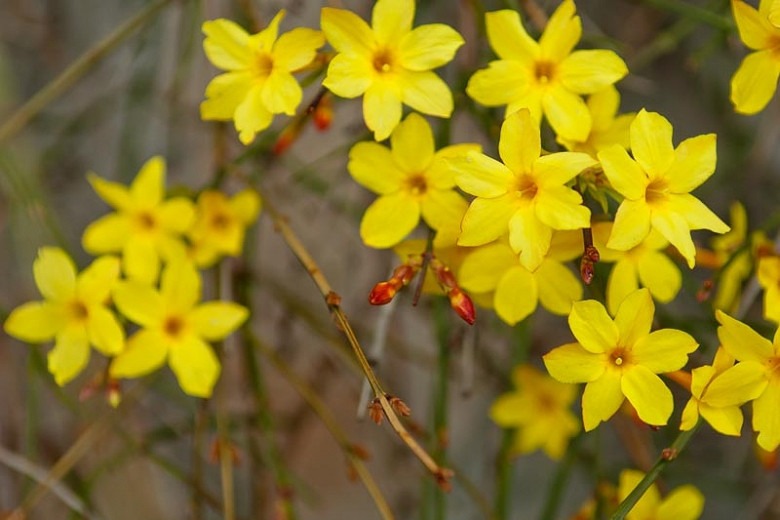
5. Common Jasmine
Scientific Name: Jasminum officinale
Plant Type: Deciduous or semi-evergreen
Plant Size: 20-30 ft
Sun Exposure: Full sun to part shade
Plant Zone: 7-10
Common Jasmine, scientifically known as Jasminum officinale, is a versatile variety that can be either deciduous or semi-evergreen. Originating from Asia, it is often underestimated due to its name, but it remains a wonderful addition to any garden. Common Jasmine is cherished for its delightful scent and its impressive size, which can fill any garden. The scent emanates from delicate clusters of white flowers.
If grown in a pot, it is advisable to bring Common Jasmine indoors during winter and keep it outside in the summer. This variety is not tolerant of cool temperatures, although it is hardier than some other jasmine species that thrive only in warmer zones. Common Jasmine can be easily pruned without harming the plant and has the ability to spread and fill the desired area.

6. Dwarf Jasmine
Scientific Name: Chrysojasminum parkeri
Plant Type: Deciduous
Plant Size: 12 in
Sun Exposure: Full sun to part shade
Plant Zone: 6-10
Dwarf Jasmine, also known as Himalayan Jasmine and Parker Jasmine, is a deciduous plant that originates from Southeast Asia. This variety remains relatively small, reaching a height of only 12 inches, but it can spread a few feet, maintaining a contained growth pattern.
Despite its petite stature, Dwarf Jasmine produces charming small yellow flowers that bloom close to the ground. While these flowers only blossom during the summer season, the evergreen leaves provide beautiful foliage throughout the year. The trumpet-shaped yellow blooms may not possess a strong scent, but they are still highly valued for their use in flower arrangements. The leaves of Dwarf Jasmine are tiny and ovular in shape.

7. Italian Jasmine
Scientific Name: Chrysojasminum humile
Plant Type: Evergreen Shrub
Plant Size: 8-13 ft
Sun Exposure: Full sun to part shade
Plant Zone: 7-9
Italian Jasmine, scientifically known as Chrysojasminum humile, offers a vibrant twist compared to other jasmine plants. Instead of white blooms, this variety features bright yellow flowers that eventually give way to blackberries. Having Italian Jasmine in your garden is an excellent way to attract pollinators.
This shrub is a great choice for those seeking an easy-to-care-for plant. It can be utilized as both a shrub and a vine, making it versatile in various settings, including colder environments. However, while it can tolerate lower temperatures, it thrives best in warm climates.
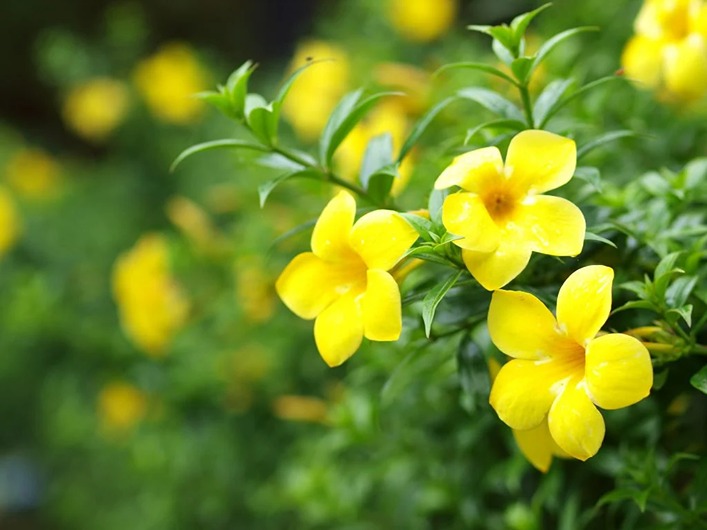
8. Forest Jasmine
Scientific Name: Jasminium abyssinicum
Plant Type: Evergreen
Plant Size: 16-18 ft
Sun Exposure: Full sun to part shade
Plant Zone: 8-11
Forest Jasmine, scientifically known as Jasminium abyssinicum, stands out among other jasmine varieties with its thicker vines. These vines are known for their prolific growth and their natural tendency to reach towards the sunlight. The plant showcases thick, glossy dark leaves and beautiful white flowers with a touch of pink.
When it comes to sunlight and soil requirements, Forest Jasmine is relatively adaptable. It can thrive in a range of sun exposure, from full sun to part shade. Additionally, it can withstand various soil types, including loamy or clayey soil. It is important to note that Forest Jasmine is a fast-growing plant, so careful consideration should be given before planting it to ensure it has enough space to flourish.
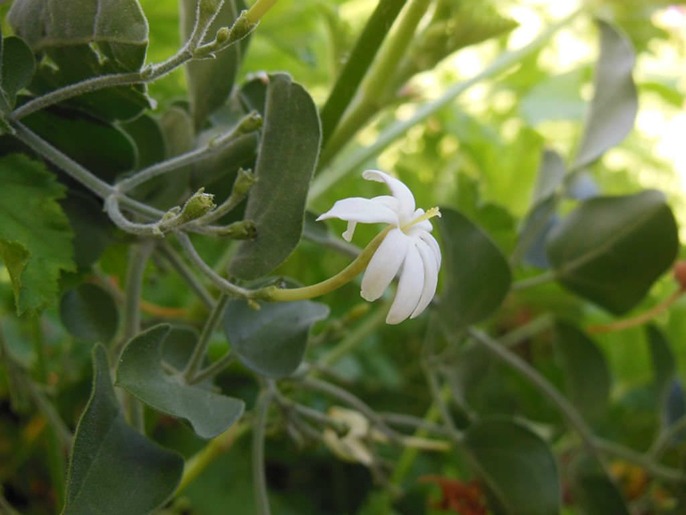
9. Lemon-Scented Jasmine
Scientific Name: Jasminum azoricum
Plant Type: Evergreen Vine
Plant Size: 10-12 ft
Sun Exposure: Full to partial sun
Plant Zone: 9-11
As the name suggests, Lemon-Scented Jasmine, scientifically known as Jasminum azoricum, is renowned for its sweet and citrusy fragrance. The blooms of this variety resemble two stacked flowers, with long and tapered petals. Expect to see these flowers in small clusters around the plant.
To ensure optimal growth, it is recommended to plant this vine in well-drained soil. While it can tolerate partial shade, Lemon-Scented Jasmine thrives when exposed to full sun. It’s important to note that this species is sensitive to cold weather and is classified as critically endangered in its native habitat.
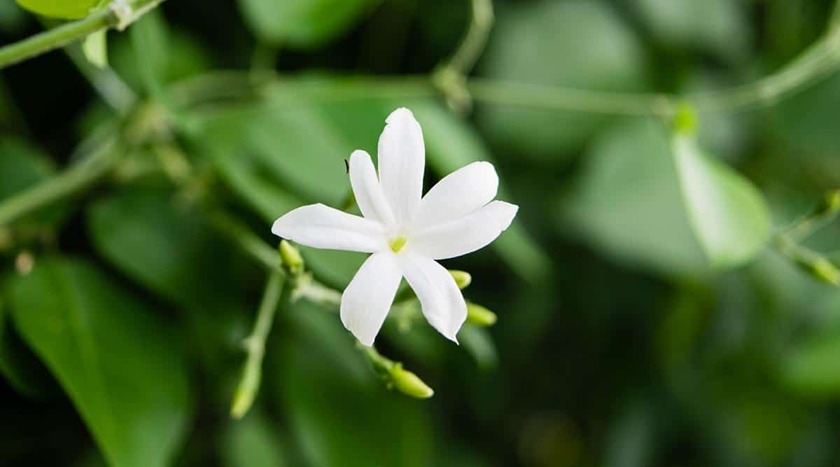
10. Pink Jasmine
Scientific Name: Jasminum polyanthum
Plant Type: Evergreen perennial
Plant Size: 25 ft
Sun Exposure: Full or part shade
Plant Zone: 8-11
Pink Jasmine, scientifically known as Jasminum polyanthum, lives up to its name with its beautiful pink flowers. However, the blooms are not deeply or boldly pink but rather delicate and very light in color, while the buds of the plant exhibit a brighter pink hue. This vine can be planted on trellises or used as a ground cover, making it a versatile option. It can also be grown in containers.
For those residing outside the suitable planting zones, Pink Jasmine can be grown as a houseplant. In such cases, it is advisable to provide support for the vine, such as a trellis, to help it climb. This variety is known for its bold fragrance, adding an enchanting aroma to any garden.
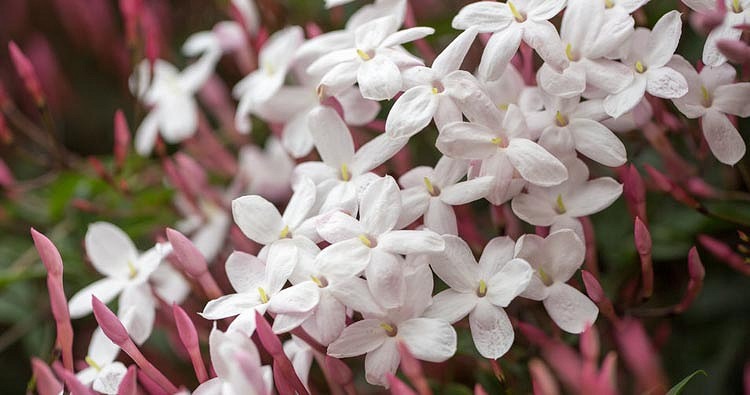
11. Stiff Jasmine
Scientific Name: Jasminum volubile
Plant Type: Evergreen
Plant Size: 2-5 ft
Sun Exposure: Full sun to part shade
Plant Zone: 8-11
Stiff Jasmine, scientifically known as Jasminum volubile, is a versatile vine that can be treated as either a shrub or a climbing plant. The flowers of this variety possess the classic jasmine appearance, showcasing beautiful white blooms that are larger compared to other jasmine species. A single plant may produce flowers with varying petal amounts. After the blooming period, small blackberries emerge.
In its native Australian habitat, Stiff Jasmine is typically found on the edges of rainforests or within dry rainforests. These plants are resilient and can thrive with minimal water requirements.

12. Primrose Jasmine
Scientific Name: Jasminum mesnyi
Plant Type: Semi-evergreen or evergreen
Plant Size: 6 ft
Sun Exposure: Full to part sun
Plant Zone: 8-10
Primrose Jasmine, scientifically known as Jasminum mesnyi, may surprise you with its large yellow flowers, which may not immediately resemble the typical appearance of jasmine plants. However, rest assured that this plant possesses all the desirable characteristics of jasmine, including its captivating beauty and delightful fragrance.
This shrub is an ideal choice for gardeners seeking low-maintenance plants. It exhibits remarkable drought resistance and can thrive in various environmental conditions. However, it is not well-suited for extreme cold temperatures. When planting this shrub, the primary consideration is pruning, as Primrose Jasmine is a fast-growing and prolific bloomer.

13. Wild Jasmine
Scientific Name: Chrysojasminum fruticans
Plant Type: Evergreen shrub
Plant Size: 12 ft
Sun Exposure: Full sun to part shade
Plant Zone: 7-11
Wild Jasmine, as the name suggests, is more reminiscent of a shrub compared to other jasmine varieties. It can be grown as a shrub or used as a groundcover, making it highly adaptable. Additionally, it performs well in hedges and hanging plant arrangements.
While Wild Jasmine thrives in full sunlight and exhibits drought tolerance, regular watering is still beneficial. Although this variety can withstand colder temperatures better than others, it is advisable to avoid planting it in regions with excessively cold climates. The plant boasts delicate, thick leaves and simple yellow flowers, but it does not produce a strong fragrance like many other jasmine plants.
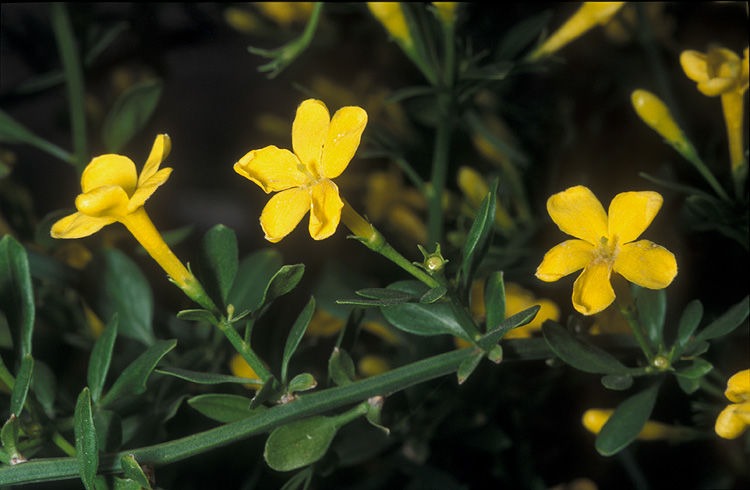
14. Downey Jasmine
Scientific Name: Jasminum pubescens
Plant Type: Evergreen
Plant Size: 8-12 ft
Sun Exposure: Full sun to part shade
Plant Zone: 9-11
Downey Jasmine, scientifically known as Jasminum pubescens, is an evergreen plant originating from Asia. It can be trained as either a shrub or a vine, depending on your preference. With proper training, Downey Jasmine can climb to considerable heights. It is a fast-growing variety, so careful consideration should be given to pruning to maintain desired size and shape.
The name “Downey Jasmine” derives from the numerous flowers that cover the plant. These flowers are small and composed of thin, tapered petals. When in full bloom, Downey Jasmine showcases remarkable beauty, although it does not possess a strong scent.
